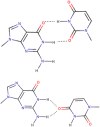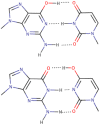The multiple flavors of GoU pairs in RNA
- PMID: 31033092
- PMCID: PMC6617799
- DOI: 10.1002/jmr.2782
The multiple flavors of GoU pairs in RNA
Abstract
Wobble GU pairs (or GoU) occur frequently within double-stranded RNA helices interspersed within the standard G═C and A─U Watson-Crick pairs. However, other types of GoU pairs interacting on their Watson-Crick edges have been observed. The structural and functional roles of such alternative GoU pairs are surprisingly diverse and reflect the various pairings G and U can form by exploiting all the subtleties of their electronic configurations. Here, the structural characteristics of the GoU pairs are updated following the recent crystallographic structures of functional ribosomal complexes and the development in our understanding of ribosomal translation.
Keywords: GoU pair; anticodon; codon; mRNA; miscoding; ribosome; tRNA; tautomer.
© 2019 The Authors Journal of Molecular Recognition Published by John Wiley & Sons Ltd.
Conflict of interest statement
None.
Figures






Similar articles
-
Tautomeric G•U pairs within the molecular ribosomal grip and fidelity of decoding in bacteria.Nucleic Acids Res. 2018 Aug 21;46(14):7425-7435. doi: 10.1093/nar/gky547. Nucleic Acids Res. 2018. PMID: 29931292 Free PMC article.
-
Anionic G•U pairs in bacterial ribosomal rRNAs.RNA. 2023 Jul;29(7):1069-1076. doi: 10.1261/rna.079583.123. Epub 2023 Apr 17. RNA. 2023. PMID: 37068913 Free PMC article.
-
Recognition of cognate transfer RNA by the 30S ribosomal subunit.Science. 2001 May 4;292(5518):897-902. doi: 10.1126/science.1060612. Science. 2001. PMID: 11340196
-
New structural insights into the decoding mechanism: translation infidelity via a G·U pair with Watson-Crick geometry.FEBS Lett. 2013 Jun 27;587(13):1848-57. doi: 10.1016/j.febslet.2013.05.009. Epub 2013 May 23. FEBS Lett. 2013. PMID: 23707250 Review.
-
tRNA's wobble decoding of the genome: 40 years of modification.J Mol Biol. 2007 Feb 9;366(1):1-13. doi: 10.1016/j.jmb.2006.11.046. Epub 2006 Nov 15. J Mol Biol. 2007. PMID: 17187822 Review.
Cited by
-
An RNA-centric historical narrative around the Protein Data Bank.J Biol Chem. 2021 Jan-Jun;296:100555. doi: 10.1016/j.jbc.2021.100555. Epub 2021 Mar 18. J Biol Chem. 2021. PMID: 33744291 Free PMC article. Review.
-
Eukaryotic tRNA sequences present conserved and amino acid-specific structural signatures.Nucleic Acids Res. 2022 Apr 22;50(7):4100-4112. doi: 10.1093/nar/gkac222. Nucleic Acids Res. 2022. PMID: 35380696 Free PMC article.
-
Two riboswitch classes that share a common ligand-binding fold show major differences in the ability to accommodate mutations.Nucleic Acids Res. 2024 Nov 27;52(21):13152-13173. doi: 10.1093/nar/gkae886. Nucleic Acids Res. 2024. PMID: 39413212 Free PMC article.
-
Structure of saguaro cactus virus 3' translational enhancer mimics 5' cap for eIF4E binding.Proc Natl Acad Sci U S A. 2024 Jan 23;121(4):e2313677121. doi: 10.1073/pnas.2313677121. Epub 2024 Jan 19. Proc Natl Acad Sci U S A. 2024. PMID: 38241435 Free PMC article.
-
Eukaryotic life without tQCUG: the role of Elongator-dependent tRNA modifications in Dictyostelium discoideum.Nucleic Acids Res. 2020 Aug 20;48(14):7899-7913. doi: 10.1093/nar/gkaa560. Nucleic Acids Res. 2020. PMID: 32609816 Free PMC article.
References
-
- Crick FH. Codon‐anticodon pairing: the wobble hypothesis. J Mol Biol. 1966;19(2):548‐555. - PubMed
Publication types
MeSH terms
Substances
LinkOut - more resources
Full Text Sources
Other Literature Sources
Miscellaneous

